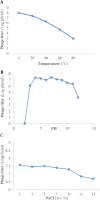In vitro evaluation of two novel Escherichia bacteriophages against multiple drug resistant avian pathogenic Escherichia coli
- PMID: 38755537
- PMCID: PMC11100137
- DOI: 10.1186/s12879-024-09402-0
In vitro evaluation of two novel Escherichia bacteriophages against multiple drug resistant avian pathogenic Escherichia coli
Abstract
Background: In recent years, there has been a growing interest in phage therapy as an effective therapeutic tool against colibacillosis caused by avian pathogenic Escherichia coli (APEC) which resulted from the increasing number of multidrug resistant (MDR) APEC strains.
Methods: In the present study, we reported the characterization of a new lytic bacteriophage (Escherichia phage AG- MK-2022. Basu) isolated from poultry slaughterhouse wastewater. In addition, the in vitro bacteriolytic activity of the newly isolated phage (Escherichia phage AG- MK-2022. Basu) and the Escherichia phage VaT-2019a isolate PE17 (GenBank: MK353636.1) were assessed against MDR- APEC strains (n = 100) isolated from broiler chickens with clinical signs of colibacillosis.
Results: Escherichia phage AG- MK-2022. Basu belongs to the Myoviridae family and exhibits a broad host range. Furthermore, the phage showed stability under a wide range of temperatures, pH values and different concentrations of NaCl. Genome analysis of the Escherichia phage AG- MK-2022. Basu revealed that the phage possesses no antibiotic resistance genes (ARGs), mobile genetic elements (MGEs), and any E. coli virulence associated genes. In vitro bacterial challenge tests demonstrated that two phages, the Escherichia phage VaT-2019a isolate PE17 and the Escherichia phage AG- MK-2022. Basu exhibited high bactericidal activity against APEC strains and lysed 95% of the tested APEC strains.
Conclusions: The current study findings indicate that both phages could be suggested as safe biocontrol agents and alternatives to antibiotics for controlling MDR-APEC strains isolated from broilers.
Keywords: Antibiotic; Avian pathogenic Escherichia coli (APEC); Bacteriophage; Broilers; Colibacillosis; Multidrug resistant (MDR).
© 2024. The Author(s).
Conflict of interest statement
The authors declare no competing interests.
Figures







Similar articles
-
Therapeutics and prophylactic efficacy of novel lytic Escherichia phage vB_EcoS_PJ16 against multidrug-resistant avian pathogenic E. coli using in vivo study.Int Microbiol. 2024 Jun;27(3):673-687. doi: 10.1007/s10123-023-00420-7. Epub 2023 Aug 26. Int Microbiol. 2024. PMID: 37632591
-
Isolation and Characterization of a Novel Phage Collection against Avian-Pathogenic Escherichia coli.Microbiol Spectr. 2023 Jun 15;11(3):e0429622. doi: 10.1128/spectrum.04296-22. Epub 2023 May 4. Microbiol Spectr. 2023. PMID: 37140373 Free PMC article.
-
Isolation and characterization of a T4-like phage with a relatively wide host range within Escherichia coli.J Basic Microbiol. 2016 Apr;56(4):405-21. doi: 10.1002/jobm.201500440. Epub 2015 Dec 23. J Basic Microbiol. 2016. PMID: 26697952
-
[Avian pathogenic Escherichia coli (APEC)].Berl Munch Tierarztl Wochenschr. 2003 Sep-Oct;116(9-10):381-95. Berl Munch Tierarztl Wochenschr. 2003. PMID: 14526468 Review. German.
-
Avian pathogenic Escherichia coli (APEC).Vet Res. 1999 Mar-Jun;30(2-3):299-316. Vet Res. 1999. PMID: 10367360 Review.
Cited by
-
Bridging the gap: Phage manufacturing processes from laboratory to agri-food industry.Virus Res. 2025 Mar;353:199537. doi: 10.1016/j.virusres.2025.199537. Epub 2025 Jan 31. Virus Res. 2025. PMID: 39880310 Free PMC article. Review.
References
-
- Nolan LK, Vaillancourt J-P, Barbieri NL, Logue CM. Colibacillosis. In: Diseases of Poultry edn.; 2020: 770–830.
-
- Bonnet C, Diarrassouba F, Brousseau R, Masson L, Topp E, Diarra MS. Pathotype and antibiotic resistance gene distributions of Escherichia coli isolates from broiler chickens raised on antimicrobial-supplemented diets. Appl Environ Microbiol. 2009;75(22):6955–62. doi: 10.1128/AEM.00375-09. - DOI - PMC - PubMed
-
- Tonini da Rocha D, De Oliveira Salle F, Apellanis Borges K, Quedi Furian T, Pinheiro do Nascimento V, Luiz, de Souza Moraes H. Tadeu Pippi Salle C: Avian pathogenic Escherichia coli (APEC) and uropathogenic Escherichia coli (UPEC): characterization and comparison. J Infect Dev Ctries 2021; 15(7):962–971. - PubMed
MeSH terms
Grants and funding
LinkOut - more resources
Full Text Sources
Medical

